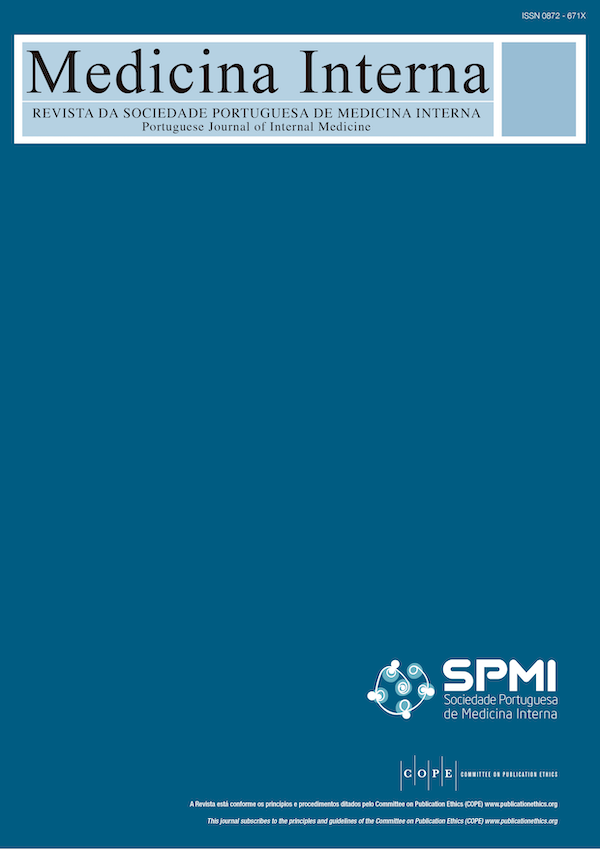Non-Invasive Ventilation in Acute Respiratory Failure
DOI:
https://doi.org/10.24950/O/320/20/2/2021Keywords:
Noninvasive Ventilation, Respiratory Distress SyndromeAbstract
Introduction: Non-invasive mechanical ventilation (NIV) is a valid, albeit non-consensual option for the treatment of patients with Acute Respiratory Failure (ARF). The following article has the main goal of identifying predictors of therapeutic response to NIV.
Methods: Retrospective longitudinal study which included patients in an Intensive Care Unit in 2016 and 2017, in whom NIV was started once they developed de novo ARF (PaO2/ FiO2 < 200). We included patients with community acquired pneumonia (CAP) and acute respiratory distress syndrome (ARDS) and compared NIV-responders to non-responders.
Results: Between 2016 and 2017, 83 patients with de novo ARF were treated with NIV. Of those, 50 (60%) were treated successfully. The most common cause of ARF was CAP, which was successfully managed with NIV in 70% of cases. NIV-responders presented lower severity scores (APACHE 2; SAPS 2; SOFA) at admission (17.5; 37.5; 6 vs 22; 48; 9, p=0.014, p=<0.01 and p<0.01, respectively). Non-responders presented significantly lower arterial pH values at admission (7.35 vs 7.42, p<0.01), PaO2/FiO2 ratio (118 vs 145, p=0.03), higher seric lactate (2.2 vs 1.46, p<0.01) as well as need for vasopressor support (51.5% vs 30%, p=0.04). The change in the PaO2/FiO2 ratio within 2 hours of treatment was wider in the group of NIV-responders, unlike non-responders (+53, p<0.01 vs +14, p=0.09).
Conclusion: NIV was an effective respiratory support strategy in 60% of patients with de novo ARF. Patients who seem to have a higher probability of NIV success are: patients with CAP; with or without moderate ARDS, rather than severe; with no respiratory acidaemia; patients with no lactacidemia or patients with no need for vasopressor therapy. The ability of NIV to significantly alter the PaO2/FiO2 ratio after 2 hours of technique seems to be a good success predictor.
Downloads
References
Official ERS/ATS clinical practice guidelines: noninvasive ventilation for acute respiratory failure. Eur Respir J. 2017; 50: 1602426
Nava S, Navalesi P, Conti G. Time of non invasive ventilation. Intensive Care Med. 2006; 32: 361-70.
Brochard L, Lefebvre JC, Cordioli RL, Akoumianaki E, Richard JC. Noninvasive ventilation for patients with hypoxemic acute respiratory failure. Semin Respir Crit Care Med. 2014; 35: 492–500. doi: 10.1055/s-0034-1383863.
Brambilla AM, Prina E, Ferrari G, Bozzano V, Ferrari R, Groff P, et al. Non-invasive positive pressure ventilation in pneumonia outside Intensive Care Unit: An Italian multicenter observational study. Eur J Intern Med. 2019; 59:21-6. doi: 10.1016/j.ejim.2018.09.025.
Ferrer M, Esquinas A, Leon M, Bozzano V, Ferrari R, Groff P, et al. Noninvasive ventilation in severe hypoxemic respiratory failure: a randomized clinical trial. Am J Respir Crit Care Med. 2003; 168: 1438-44. doi: 10.1016/j.ejim.2018.09.025.
Keenan SP, Sinuff T, Burns KE, Muscedere J, Kutsogiannis J, Mehta S, et al. Clinical practice guidelines for the use of noninvasive positive-pressure ventilation and noninvasive continuous positive airway pressure in the acute care setting. CMAJ. 2011; 183: E195-E214. doi: 10.1503/cmaj.100071.
Knaus WA, Draper EA, Wagner DP, Zimmerman JE. APACHE II: a severity of disease classification system. Crit Care Med. 1985;13:818-29.
Le Gall JR, Lemeshow S, Saulnier F. A new Simplified Acute Physiology Score (SAPS II) based on a European/North American multicenter study. JAMA. 1993;270:2957-63.
Vincent JL, Moreno R, Takala J, Willatts S, De Mendonça A, Bruining H, et al. The SOFA (Sepsis-related Organ Failure Assessment) score to describe organ dysfunction/failure. On behalf of the Working Group on Sepsis-Related Problems of the European Society of Intensive Care Medicine. Intensive Care Med. 1996;22:707-10. doi: 10.1007/BF01709751.
Kramer N, Meyer TJ, Meharg J, Cece RD, Hill NS. Randomized, prospective trial of noninvasive positive pressure ventilation in acute respiratory failure. Am J Respir Crit Care Med. 1995; 151: 1799 –806. doi: 10.1164/ajrccm.151.6.7767523.
Martin-Gonzalez F, Gonzalez-Robledo J, Sanchez-Hernandez F, Moreno-Garcia MN, Barreda-Mellado. Effectiveness and predictors of failure of noninvasive mechanical ventilation in acute respiratory failure. Med Intensiva. 2016, 40: 9-17
Duke GJ. Cardiovascular effects of mechanical ventilation. Crit Care Resusc. 1999;1:388-99.
Antonelli M, Conti G, Moro ML, Esquinas A, Gonzalez-Diaz G, Confalonieri M, et al. Predictors of failure of noninvasive positive pressure ventilation in patients with acute hypoxemic respiratory failure: a multi-center study. Intensive Care Med. 2001;27:1718-28. doi: 10.1007/s00134-001-1114-4.
Downloads
Published
How to Cite
Issue
Section
License

This work is licensed under a Creative Commons Attribution 4.0 International License.
Copyright (c) 2023 Medicina Interna






